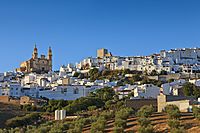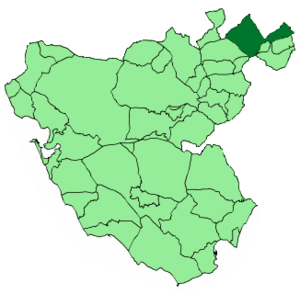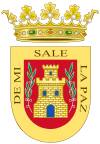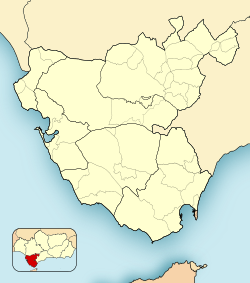Olvera facts for kids
Quick facts for kids
Olvera
|
|||
|---|---|---|---|

Olvera at sunset
|
|||
|
|||

Location of Olvera
|
|||
| Autonomous community | Andalusia | ||
| Province | Cádiz | ||
| Comarca | Sierra de Cádiz | ||
| Area | |||
| • Total | 194 km2 (75 sq mi) | ||
| • Land | 194 km2 (75 sq mi) | ||
| • Water | 0.00 km2 (0 sq mi) | ||
| Population
(2018)
|
|||
| • Total | 8,124 | ||
| • Density | 41.88/km2 (108.46/sq mi) | ||
| Time zone | UTC+1 (CET) | ||
| • Summer (DST) | UTC+2 (CEST) | ||
| Website | olvera.es | ||
Olvera is a charming town located in the province of Cádiz, in the region of Andalusia, Spain. In 2005, about 8,585 people lived here. It's known for its beautiful white houses and stunning views.
Contents
Discovering Olvera: A Spanish Town
Olvera is often called the "tip" of the "White towns route". This means it's one of the first towns you see on a famous trail of villages with whitewashed buildings. It sits in the northwest part of the Serranía Gaditana area. This area is close to the borders of Seville and Malaga provinces.
The town is about 643 meters (2,109 feet) above sea level. Its land area covers about 194 square kilometers (75 square miles). Olvera is about 139 kilometers (86 miles) away from the capital city of Cádiz. In 2021, the population was around 8,016 people. However, many "Olvereños" (people from Olvera) might live elsewhere. Some move to the coast, like the Costa de la Luz, for work.
The hills around Olvera are covered in olive groves. Many people say these groves produce some of the best olive oils in Andalusia. It's believed that over 2 million olive trees surround the town! Olvera has even won an award for its olive oil. This award, called "Denominación de Origen de la Sierra de Cádiz," recognizes high-quality products.
While olive oil is very important, the town's biggest economic strength comes from "cooperatives." These are groups of people who work together for a common goal. Olvera won the "Arco Iris" prize in 1989. This was because it had the most cooperatives per person.
A special natural area near Olvera is the "Peñon de Zaframagón." This huge rock is home to a large group of Andalusian griffon vultures. These amazing birds can be found about 14 kilometers (9 miles) northwest of the town center.
Olvera's Past: A Journey Through Time
| Historical population | ||
|---|---|---|
| Year | Pop. | ±% |
| 1999 | 8,818 | — |
| 2000 | 8,685 | −1.5% |
| 2001 | 8,538 | −1.7% |
| 2002 | 8,614 | +0.9% |
| 2003 | 8,584 | −0.3% |
| 2004 | 8,549 | −0.4% |
| 2005 | 8,585 | +0.4% |
| Source: INE (Spain) | ||
Historians are still trying to figure out the exact origin of Olvera. Some think it might have been a Celtic settlement called Caricus. Others believe it was the legendary Cenosia, known as Vallehermoso (beautiful valley), during the time of the Visigoths.
Many Roman camps and remains have been found in the Sierra de Lijar mountain range. An archaeologist's report from 1986 showed a Roman settlement from the late 3rd century B.C. Even the foundations of Olvera's castle were found to be Roman! The town might have been called "Ilipa," "Hippa," or "Hippo Nova" originally.
The first clear records of Olvera come from Muslim writings in the mid-12th century. It was called "WUBIRA" or "URIWILA." In 1327, King Alfonso XI took the town from the Arabs. Olvera became important in the Christian plan to move towards the Straits of Gibraltar. This was to stop the Muslims from becoming strong again.
After the town surrendered, the Muslim leader Ibrahim-ibn-Utmain made a deal. He ensured that the Muslim people of Olvera could keep their homes and belongings. The town was then repopulated with new settlers. A special decree, called a 'Letter of Population,' was issued on August 1, 1327. This decree even allowed criminals and debtors to clear their names by staying in the Nazarí (Granada province) area for a year.
The new Christian king named the town Olivera. This was to remember the many olive trees around it. Over time, the "i" sound was dropped, leading to the name "Olvera" we use today.
In the mid-14th century, the town came under the control of Don Alfonso Perez de Guzman. Olvera also saw a small group of Napoleonic soldiers. Local fighters constantly bothered them until the French left in 1812.
Later, two noble families ruled Olvera. The last one was the Dukes of Osuna, who were feudal lords until 1843. They went bankrupt, and their rule ended.
Olvera played a part in big moments in Spanish history during the 19th century. After a revolution in September 1868, the monarchy returned. In 1877, King Alfonso XII gave Olvera the title of "City." This was to thank the town for providing horses during one of the Carlist wars.
During the dictatorship of Franco, Olvera residents benefited from a new project. A railroad was being built from Jerez to Almargen, ending in Olvera. The project was never finished, but the path is now a famous "Via Verde." This is a nature walk about 40 kilometers (25 miles) long.
In 1983, Olvera was officially named "A Protected Area of Artistic and Historical Importance." This means its beauty and history are preserved. Today, Olvera focuses on farming, forestry, and raising animals. These activities are supported by tourism and the town's many cooperatives.
A famous person born in Olvera was Nicholas de Ribera, El Viejo. He was born in 1487 and helped conquer Peru. In 1535, he became the first mayor of Lima.
How Olvera Makes a Living
Today, Olvera's economy mostly relies on family cooperatives. These groups work together in farming, tourism, and the construction industry along the coast.
Exploring Olvera's Famous Landmarks
The town of Olvera itself is considered a major monument. People often say, "OLVERA is a street, a church, and a castle, BUT what a street, what a church, and what a castle!" This is why Olvera was declared "A Protected Area of Artistic and Historical Importance" in 1983.
Nuestra Señora de la Encarnación Church
This church, called Parroquia de Nuestra Señora de la Encarnación, stands tall like the top of a pyramid. It's right next to the Arabic Castle, looking over the white houses and olive groves. This church has a neoclassic style. It was built starting in 1822 by the Duke of Osuña.
The church was built on the site of an older, smaller Gothic-Mudéjar style church. That church, in turn, was built on the foundations of an Arabic mosque. The work on the current church finished in 1843. It became one of the largest churches in the province, almost like a cathedral. During the Spanish Civil War in 1936, some of its religious statues and the interior were burned.
Inside, you can find beautiful frescos (wall paintings) and valuable stained-glass windows. There are also statues showing different parts of Christ's death. One of these is a Crucified Christ from the 16th century, found in the building's cellars about 15 years ago. The church was restored from 1994 to 1999. It had to close again in 2004 after a fire damaged a statue. People hope to raise money to reopen it soon.
The Arab Castle
The castle you see today was built mostly in the 13th century. It sits on a very important rock, allowing people to send signals to other castles nearby. Its design was made to give it the best advantage against enemies.
The Moorish Wall
The old Moorish wall has seven strong supports. Part of the wall was taken down, which highlighted a building called the "Cilla." This building was once a jail and a storage place for the duke. Today, it's a tourist office and a town museum. It has four display rooms and a patio with an amazing view. One room has a permanent exhibit about the "Castles and Strengths of the Nazarí Kingdoms."
La Villa District
Close to the castle and church is "La Villa," the ancient town center. Walking through its narrow streets feels like going back 700 years. This was where the old Visigoth town of Wubira once stood. You can still see the town's old roots here. The narrow streets and old cottages show the mix of ancient Muslim architecture with newer styles.
La Plaza de Andalusia
This plaza is also called "La Alameda," which means a tree-lined area. It has a beautiful stone fountain and waterfall built in 2004. Above the plaza is "el Peñón del Sagrado Corazón de Jesús." This is a large rock garden filled with ivy, flowers, birds, and animals. It's named after a statue of Christ with raised arms. Jose Even Navas carved this statue in 1929, and it sits on the highest part of the rock.
El Santuario de Nuestra Señora de Los Remedios
The Sanctuary of Our Lady of the Remedies is about 2 kilometers (1.2 miles) from the town center. It was built in the 18th century in an Andalusian style. It stands on the foundations of a smaller chapel. This sanctuary honors the patron saint of Olvera, Nuestra Señora de Los Remedios. She is loved by the people of Olvera and many towns around, known as "las cientos sierras" (the 100 mountain ranges). An original statue of her was made in the 16th century and restored about 10 years ago.
El Monasterio de Caño Santos
This monastery is located 7 kilometers (4.3 miles) from Olvera. It was built in 1542. For many years, it was home to the old patron saint of the city, the Holy Virgin of Caño. Franciscan friars lived here and cared for the statue. In 1835, the friars were forced to leave, and the monastery was taken and left empty. After many years, when the building was almost lost, the government of Andalusia decided to restore it. Even though it's in Olvera's area, the monastery belongs to the city council of Alcala del Valle.
See also
 In Spanish: Olvera para niños
In Spanish: Olvera para niños








